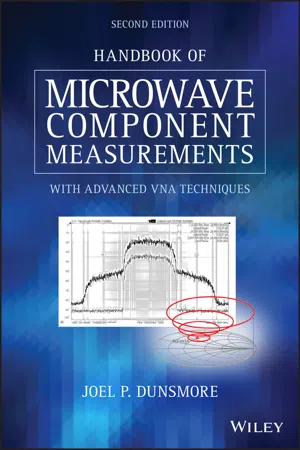
Handbook of Microwave Component Measurements
with Advanced VNA Techniques
- English
- ePUB (mobile friendly)
- Available on iOS & Android
About this book
Handbook of Microwave Component Measurements Second Edition is a fully updated, complete reference to this topic, focusing on the modern measurement tools, such as a Vector Network Analyzer (VNA), gathering in one place all the concepts, formulas, and best practices of measurement science. It includes basic concepts in each chapter as well as appendices which provide all the detail needed to understand the science behind microwave measurements. The book offers an insight into the best practices for ascertaining the true nature of the device-under-test (DUT), optimizing the time to setup and measure, and to the greatest extent possible, remove the effects of the measuring equipment from that result. Furthermore, the author writes with a simplicity that is easily accessible to the student or new engineer, yet is thorough enough to provide details of measurement science for even the most advanced applications and researchers. This welcome new edition brings forward the most modern techniques used in industry today, and recognizes that more new techniques have developed since the first edition published in 2012. Whilst still focusing on the VNA, these techniques are also compatible with other vendor's advanced equipment, providing a comprehensive industry reference.
Frequently asked questions
- Essential is ideal for learners and professionals who enjoy exploring a wide range of subjects. Access the Essential Library with 800,000+ trusted titles and best-sellers across business, personal growth, and the humanities. Includes unlimited reading time and Standard Read Aloud voice.
- Complete: Perfect for advanced learners and researchers needing full, unrestricted access. Unlock 1.4M+ books across hundreds of subjects, including academic and specialized titles. The Complete Plan also includes advanced features like Premium Read Aloud and Research Assistant.
Please note we cannot support devices running on iOS 13 and Android 7 or earlier. Learn more about using the app.
Information
1
Introduction to Microwave Measurements
1.1 Modern Measurement Process
- Pretest: This important first step is often ignored, resulting in meaningless measurements and wasted time. During the pretest, measurements of the device‐under‐test (DUT) are performed to coarsely determine some of its attributes. During pretest, it is also determined if the DUT is plugged in, turned on, and operating as expected. Many times the gain, match, or power handling is discovered to be different than expected, and much time and effort can be saved by finding this out early.
- Optimize: Once the coarse attributes of the device have been determined, the measurement parameters and measurement system can be optimized to give the best results for that particular device. This might include adding an attenuator to the measurement receivers, adding booster amplifiers to the source, or just changing the number of points in a measurement to capture the true response of the DUT. Depending upon the device's particular characteristic response relative to the system errors, different choices for calibration methods or calibration standards might be required.
- Calibrate: Many users will skip to this step, only to find that something in the setup does not provide the needed conditions and they must go back to the first step, retest, and optimize before recalibration. Calibration is the process of characterizing the measurement system so that systematic errors can be removed from the measurement result. This is not the same as obtaining a calibration ...
Table of contents
- Cover
- Table of Contents
- Foreword to the Second Edition
- Foreword to the First Edition
- Preface to the Second Edition
- Preface to the First Edition
- Acknowledgments for the Second Edition
- Acknowledgments from the First Edition
- 1 Introduction to Microwave Measurements
- 2 VNA Measurement Systems
- 3 Calibration and Vector Error Correction
- 4 Time‐Domain Transforms
- 5 Measuring Linear Passive Devices
- 6 Measuring Amplifiers
- 7 Mixer and Frequency Converter Measurements
- 8 Spectrum Analysis: Distortion and Modulation Measurements
- 9 Measuring Noise Figure and Noise Power
- 10 VNA Balanced Measurements
- 11 Advanced Measurement Techniques
- Appendix APhysical Constants
- Appendix BCommon RF and Microwave Connectors
- Appendix CCommon Waveguides
- Appendix DSome Definitions for Calibration Kit Opens and Shorts
- Appendix EFrequency, Wavelength, and Period
- Index
- End User License Agreement